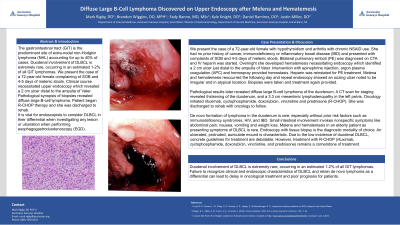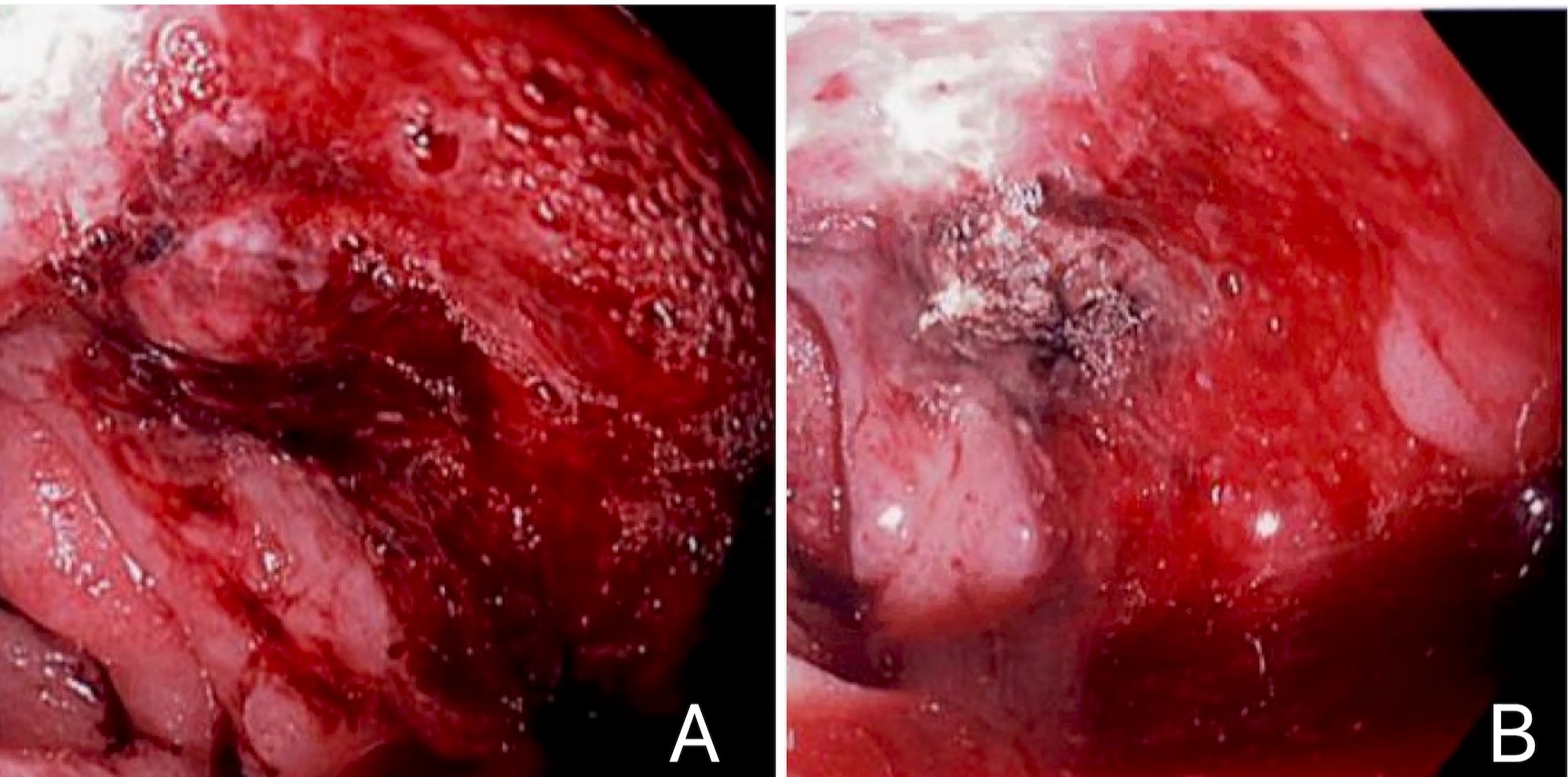Tuesday Poster Session
Category: GI Bleeding
P3488 - Diffuse Large B-Cell Lymphoma Discovered on Upper Endoscopy After Melena and Hematemesis
Tuesday, October 24, 2023
10:30 AM - 4:00 PM PT
Location: Exhibit Hall

Has Audio

Mark Rigby, DO
Ascension Genesys Hospital
Grand Blanc, MI
Presenting Author(s)
Mark Rigby, DO, Brandon Wiggins, DO, MPH, Kyle Knight, DO, Fady Banno, MD, MS, Daniel Ramirez, DO, Justin Miller, DO
Ascension Genesys Hospital, Grand Blanc, MI
Introduction: The gastrointestinal tract (GIT) is a predominant site of extranodal non-Hodgkin lymphoma (NHL) accounting for up to 40% of cases. Duodenal involvement of diffuse large B-cell lymphoma (DLBCL) is extremely rare, occurring in an estimated 1-2% of all GIT lymphomas. It is vital to consider DLBCL when investigating any lesion or ulceration when performing endoscopy.
Case Description/Methods: We present the case of a 72-year-old female with hypothyroidism and arthritis with chronic NSAID use. She had no prior history of cancer, immunodeficiency or inflammatory bowel disease (IBD) and presented with complaints of SOB and 4-5 days of melenic stools. Bilateral pulmonary emboli (PE) was diagnosed on CTA and IV heparin was started. Overnight she developed hematemesis necessitating endoscopy which identified a 2 cm ulcer just distal to the ampulla of Vater. Intervention with epinephrine injection, argon plasma coagulation (APC) and hemospray provided hemostasis. Heparin was reinstated for PE treatment. Melena and hematemesis reoccurred the following day and repeat endoscopy showed an oozing ulcer noted to be irregular and in atypical location. Biopsies were taken and treatment again provided. Pathological results later revealed diffuse large B-cell lymphoma of the duodenum. A CT scan for staging revealed thickening of the duodenum, and a 3.3 cm mesenteric lymphadenopathy in the left pelvis. Oncology initiated rituximab, cyclophosphamide, doxorubicin, vincristine and prednisone (R-CHOP). She was discharged to rehab with oncology to follow.
Discussion: De novo formation of lymphoma in the duodenum is rare, especially without prior risk factors such as immunodeficiency syndromes, HIV, and IBD. Small intestinal involvement invokes nonspecific symptoms like abdominal pain, nausea, vomiting and weight loss. Melena and hematemesis in an elderly patient as presenting symptoms of DLBCL is rare. Endoscopy with tissue biopsy is the diagnostic modality of choice. An ulcerated, protruded, auriculate mound is characteristic. Due to the low incidence of duodenal DLBCL, concrete guidelines for treatment are debatable. However, treatment with R-CHOP (rituximab, cyclophosphamide, doxorubicin, vincristine, and prednisone) remains a cornerstone of treatment. Failure to recognize clinical and endoscopic characteristics of DLBCL and retain de novo lymphoma as a differential can lead to delay in oncological treatment and poor prognosis for patients.

Disclosures:
Mark Rigby, DO, Brandon Wiggins, DO, MPH, Kyle Knight, DO, Fady Banno, MD, MS, Daniel Ramirez, DO, Justin Miller, DO. P3488 - Diffuse Large B-Cell Lymphoma Discovered on Upper Endoscopy After Melena and Hematemesis, ACG 2023 Annual Scientific Meeting Abstracts. Vancouver, BC, Canada: American College of Gastroenterology.
Ascension Genesys Hospital, Grand Blanc, MI
Introduction: The gastrointestinal tract (GIT) is a predominant site of extranodal non-Hodgkin lymphoma (NHL) accounting for up to 40% of cases. Duodenal involvement of diffuse large B-cell lymphoma (DLBCL) is extremely rare, occurring in an estimated 1-2% of all GIT lymphomas. It is vital to consider DLBCL when investigating any lesion or ulceration when performing endoscopy.
Case Description/Methods: We present the case of a 72-year-old female with hypothyroidism and arthritis with chronic NSAID use. She had no prior history of cancer, immunodeficiency or inflammatory bowel disease (IBD) and presented with complaints of SOB and 4-5 days of melenic stools. Bilateral pulmonary emboli (PE) was diagnosed on CTA and IV heparin was started. Overnight she developed hematemesis necessitating endoscopy which identified a 2 cm ulcer just distal to the ampulla of Vater. Intervention with epinephrine injection, argon plasma coagulation (APC) and hemospray provided hemostasis. Heparin was reinstated for PE treatment. Melena and hematemesis reoccurred the following day and repeat endoscopy showed an oozing ulcer noted to be irregular and in atypical location. Biopsies were taken and treatment again provided. Pathological results later revealed diffuse large B-cell lymphoma of the duodenum. A CT scan for staging revealed thickening of the duodenum, and a 3.3 cm mesenteric lymphadenopathy in the left pelvis. Oncology initiated rituximab, cyclophosphamide, doxorubicin, vincristine and prednisone (R-CHOP). She was discharged to rehab with oncology to follow.
Discussion: De novo formation of lymphoma in the duodenum is rare, especially without prior risk factors such as immunodeficiency syndromes, HIV, and IBD. Small intestinal involvement invokes nonspecific symptoms like abdominal pain, nausea, vomiting and weight loss. Melena and hematemesis in an elderly patient as presenting symptoms of DLBCL is rare. Endoscopy with tissue biopsy is the diagnostic modality of choice. An ulcerated, protruded, auriculate mound is characteristic. Due to the low incidence of duodenal DLBCL, concrete guidelines for treatment are debatable. However, treatment with R-CHOP (rituximab, cyclophosphamide, doxorubicin, vincristine, and prednisone) remains a cornerstone of treatment. Failure to recognize clinical and endoscopic characteristics of DLBCL and retain de novo lymphoma as a differential can lead to delay in oncological treatment and poor prognosis for patients.

Figure: A) 2 cm, bleeding ulcer just distal to the ampulla of vater. B) Subsequent image of ulcer, better visualized
Disclosures:
Mark Rigby indicated no relevant financial relationships.
Brandon Wiggins indicated no relevant financial relationships.
Kyle Knight indicated no relevant financial relationships.
Fady Banno indicated no relevant financial relationships.
Daniel Ramirez indicated no relevant financial relationships.
Justin Miller indicated no relevant financial relationships.
Mark Rigby, DO, Brandon Wiggins, DO, MPH, Kyle Knight, DO, Fady Banno, MD, MS, Daniel Ramirez, DO, Justin Miller, DO. P3488 - Diffuse Large B-Cell Lymphoma Discovered on Upper Endoscopy After Melena and Hematemesis, ACG 2023 Annual Scientific Meeting Abstracts. Vancouver, BC, Canada: American College of Gastroenterology.
